As the professional-grade skin care market continues to expand, manufacturers and suppliers face an evolving landscape driven by changing consumer preferences, demographics, and market conditions. We spoke to Erik Haines, managing director of data insight firm Guidepoint Qsight, for his analysis of the forces shaping this sector, with a focus on product trends, geographic and demographic shifts, and effective strategies for brand growth.
Key drivers of consumer interest
The professional-grade skin care market is experiencing robust growth, fueled by several key factors. “The growing interest in professional-grade skin care products may be driven by increased consumer awareness of skin care ingredients, the demand for visible results, and the rise of aesthetic treatments that complement these products,” Haines explained.
He also highlighted the role of social media in this trend, stating that influencer endorsements “boost trust in professional-grade brands.”
Within the professional-grade skin care segment, anti-aging and brightening products are leading the charge. According to Haines, “Anti-aging products are highly represented among the top-selling professional-grade skin care products.” Further, he added, “brightening and anti-aging concerns are among the most popular skin care issues, with moisturizers, creams, and lotions being the top form factors.”
This aligns with consumer demand for visible improvements and effective results, a trend that continues to influence product development. Haines noted that “brightening products have increased their share of total sales over time, indicating an increased focus on brightening for consumers.”
Demographic and regional trends
Geographic and demographic trends also play a significant role in the success of professional-grade skin care brands. Spending patterns vary across generations, with older consumers tending to invest more per visit.
“As of 2024, Boomers spend an average of $165 per visit on professional-grade skin care products, while Gen X customers spend around $156, and Millennials spend about $139. Gen Z customers spend less, around $120 per visit,” Haines shared.
Regionally, practices in the Midwest see slightly higher sales of professional-grade skin care products compared to other areas, which provides useful data for manufacturers aiming to optimize their distribution strategies.
Importance of brand loyalty
Brand loyalty is a critical component in the professional-grade skin care market, as the higher price point of these products makes consumers less likely to experiment. Haines pointed out that “professional-grade skin care products tend to be significantly more expensive than general retail options, creating barriers for risk-averse customers.”
This highlights the importance of loyalty programs and retention strategies for brands looking to maintain and grow their customer base.
“According to Guidepoint Qsight Sales Measurement data, around a third of all professional-grade skin care customers in 2022 purchased products from the same brand again in 2023,” Haines added, underlining the importance of fostering loyalty in a competitive market.
Innovation, product development & marketing strategies
As the market for professional-grade skin care products continues to grow, innovation remains a priority for manufacturers. As brightening products in particular continue to gain popularity, Haines advised that “manufacturers should continue to monitor how demand for different concerns and conditions changes over time.”
In addition to brightening, the demand for post-aesthetic treatment care is shaping product development. “Brands have tapped into the rising interest in non-invasive aesthetic treatments, creating innovative products that address specific aesthetic concerns without surgery,” Haines said. This approach highlights the synergy between professional skin care products and aesthetic procedures.
Targeted marketing strategies tailored to specific demographics are also proving highly effective in the professional-grade skin care market. “Brands offering professional-grade skin care products have found that marketing strategies aligned with industry trends and tailored to specific age demographics are very effective,” Haines noted.
By utilizing consumer data, manufacturers can refine their approach, creating personalized campaigns that resonate with different age groups and customer segments.
A prime example is the rising influence of Gen Z, which now accounts for 8% of professional-grade skin care consumers. “Our data shows that Gen Z consumers tend to spend more on acne treatment, scar treatment, and sun care products compared to other generations,” Haines revealed, which underscores the importance of understanding and catering to emerging segments.
Transparency and sustainability
As consumers become more discerning, the demand for product transparency, sustainability, and traceability has risen. “Consumers are becoming more educated on professional-grade skin care, and their need to understand product transparency, sustainability, and traceability has become increasingly important,” Haines emphasized.
By clearly communicating the origins of ingredients and sustainable practices, brands can build trust and attract conscious consumers.
For manufacturers, positioning themselves as transparent and responsible can be a key differentiator in a crowded market. This trend is likely to continue as consumer awareness around environmental and ethical issues grows. As Haines succinctly concluded, “staying attuned to market shifts and consumer preferences allows brands to remain relevant and engaging, leading to greater success in the market.”

